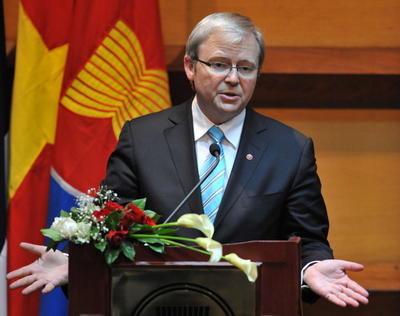Rudd argued that an APC should include a trinity of structural components: first, it must be ‘[a] regional institution which spans the entire Asia Pacific including the United States, Japan, China, Russia, India … [and] Indonesia’; second, the APC should be able to engage in and act upon a range of economic, political and security matters; and third, APC meetings must be held at the heads of government level.
But there are two distinct characterisations of an APC that warrant examination: a de facto and a substantive version. A de facto APC would be realised when the trinity of explicit, but not implicit, components of an APC is adopted or adapted into the region’s multilateral architecture — either adopted through a new institution or adapted into an existing one, such as an enlarged East Asia Summit (EAS). A de facto APC in this mould would remain a talk-shop in keeping with the ASEAN Way: regional cooperation guided by a preoccupation with process as opposed to outcomes, consensus-based decision making and non-interference in other member states’ affairs.
A substantive APC could be accomplished when, in addition to the trinity of explicit structural components, Rudd’s implied fourth limb of an APC materialised. That is, an institution that became the region’s premier one-stop-shop for fostering the habits of cooperation and not resorting to conflict. An APC Way of regional cooperation would not seek to undermine ASEAN’s role as the principal driver of Asia Pacific regionalism (as Rudd pointed out). Rather, an APC Way would catalyse the process of spurring ASEAN norms of unstructured, ritualistic meetings with a more muscular — or crisis-ready — modus operandi of regional cooperation. This would be manifested in more robust ex ante and ex post crisis mitigation and management practices than is evidenced by the status quo.
The announcement of the APC in 2008 was marred by failures of preparation and presentation. Only after a series of speeches throughout 2008 and 2009 did Rudd better articulate what the APC was and was not, as well as its rationales. From the outset, the APC concept was not restricted to being an institution per se. It simply represented these four components, which if adopted or adapted — at either the de facto or substantive level — would to varying degrees address design flaws present within the region’s current multilateral architecture. Rudd’s approach sought not to preclude any other existing regional institution from taking the lead in adopting the principles that characterise an APC.
In 2010 the EAS announced that the next summit, to be held in Indonesia in November this year, would expand to 18 members so as to include the United States and Russia. At a de facto level, it can be argued that an APC has taken shape. But whether an APC will be realised at a substantive level does not just depend upon fulfilment of the structural and membership requirements. It also depends on whether both the structure and the substantive spirit of an APC can be achieved. That is, an enlarged EAS must be recognised by its stakeholders as the region’s premier one-stop-shop multilateral institution.
For an APC to wield influence, credibility and ultimately utility, it would need China’s support. The nature of China’s future regional projection is difficult to forecast with any certainty — a dilemma compounded by a schism of views within China about its appropriate role in the region. This is exacerbated by China’s perceived double-bind dilemma, or shuangchong zhiyue 双重制约: China is damned if it does and damned if it doesn’t take an active regional role. When China is active in the region, influential Chinese figures argue that China-threat theorists attack an increasingly assertive China as undermining regional stability. But when China is passive, it is perceived to be shirking the responsibilities that its status as a major power now requires. China’s double-bind will intensify as its foreign policy increasingly moves from ‘biding one’s time and hiding one’s capacities’, taoguang yanghui 韬光养晦 to the latter half of Deng’s guiding foreign policy maxim, ‘to really become something’, or yousuo zuowei 有所作为. As China naturally seeks to preserve or enhance its growing interests abroad, China’s foreign policy behaviour will accordingly resemble that of a proactive regional player. Mitigating these anxieties and maximising the chances of China’s positive-sum integration within the region is now an urgent task.
Dialogue and policy cooperation can help reassure the region that China will not become a revisionist state while easing China’s double-bind more effectively than through the existing hodge-podge of regional institutions.
Despite premature speculation that Rudd’s APC was dead in the water, the region could instead be about to witness the green shoots of his APC. Only time and the will of the region’s great powers — especially China — will tell to what extent this de facto APC, through an enlarged EAS, will prove a pyrrhic victory or a meaningful success in activist Australian middle-power diplomacy. What is certain is that Rudd deserves to be congratulated for beginning the conversation about where we need to go.
Henry Makeham is a Founder of the Australia-China Youth Dialogue. He will be joining international law firm Davis Polk & Wardwell LLP in Hong Kong in 2012 as a trainee solicitor.

